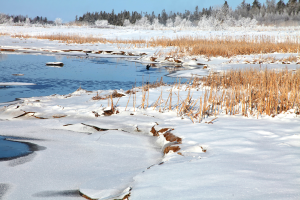by Andres Clavier, Freshwater Stewardship Education Intern
Salts, a common winter ally for icy streets, have profound ecological impacts as the melted snow and ice wash these salts away. What role, if any, do natural buffers of vegetation along shorelines provide in protecting waterbodies against this alarming pollution?
A natural buffer predominantly comprises vegetation like trees, shrubs, and grasses placed along water body edges. These buffers play a pivotal role in maintaining the health of our aquatic ecosystems. Natural Buffers, especially those with robust root systems, anchor the soil and can sieve out salt particles and other contaminants, delaying or preventing their transfer to freshwater bodies (Herbert, et al., 2015). Certain plants have the capacity to absorb limited amounts of salt from the soil, acting as a natural sieve. Though there is a ceiling to this absorption, even minor uptakes can reduce the salt content seeping into water bodies (Tully, et al., 2010).

The ground beneath these vegetative buffers can improve infiltration, thereby reducing the polluted runoff directly entering nearby waterbodies. While buffers do slow down large immediate influxes of chloride to the waterbody, the eventual soil infiltration may lead to longer term storage of the salts. Vegetative buffers have many other benefits that enhance soil quality, which often teems with microbes. These microorganisms can degrade or alter pollutants, though their efficacy with salts appears to be limited (Cooper, et al., 2014).
Moreover, salts may be a hidden risk for restoration planting work that is completed since the salt can directly impact riparian vegetation buffers. This means that when these buffers are planted, extra care should be given for any adjacent salt application. The threat of salt to vegetation is seen by the many grass patches adjacent to sidewalks and highways destroyed by salt runoff and salt spray.
Natural buffers are not able to mitigate everything. While the promise of natural buffers is enticing, they have limitations when it comes to salts. Over time and with excessive salt exposure, buffers can become less efficient at stabilizing soils, absorbing overland runoff, and providing critical wildlife habitat. Their salt absorption is especially diminished in colder months when plants are dormant and the ground is less permeable (Vidon, et al., 2008). For long-term effectiveness, the focus should be on strategies like moderating salt use and exploring de-icing alternatives.
Protecting our freshwater sources is important, and it is our collective responsibility to harmonize our actions accordingly. You can do your part by sharing the resources and information from Watersheds Canada’s salt awareness campaign!
References
Cooper, C. A., Mayer, P. M., & Faulkner, B. R. (2014). Effects of road salts on groundwater and surface water dynamics of sodium and chloride in an urban restored stream. Biogeochemistry, 121(1), 149-166.
Herbert, E. R., Boon, P., Burgin, A. J., Neubauer, S. C., Franklin, R. B., Ardón, M., … & Megonigal, J. P. (2015). A global perspective on wetland salinization: ecological consequences of a growing threat to freshwater wetlands. Ecosphere, 6(10), 1-43.
Tully, K. L., Lawrence, G. B., & Groffman, P. M. (2010). Changes in weather and climate: response of a system of automated weather stations in New York and Pennsylvania. Journal of Applied Meteorology and Climatology, 49(6), 1252-1262.
Vidon, P., Allan, C., Burns, D., Duval, T. P., Gurwick, N., Inamdar, S., … & Sebestyen, S. (2008). Hot spots and hot moments in riparian zones: potential for improved water quality management1. JAWRA Journal of the American Water Resources Association, 44(2), 278-298.
This piece is part of an education toolkit generously funded by:


